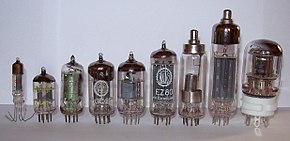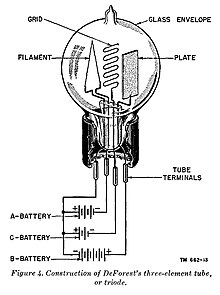
Back Vakuumbuis Afrikaans Elektronenröhre ALS صمام مفرغ Arabic Válvula termoiónica AST Vakuum borusu Azerbaijani Радыёлямпа Byelorussian Електронна лампа Bulgarian নির্বাত নল Bengali/Bangla Elektronska cijev BS Tub termoiònic Catalan

A vacuum tube, electron tube,[1][2][3] valve (British usage), or tube (North America)[4] is a device that controls electric current flow in a high vacuum between electrodes to which an electric potential difference has been applied.
The type known as a thermionic tube or thermionic valve utilizes thermionic emission of electrons from a hot cathode for fundamental electronic functions such as signal amplification and current rectification. Non-thermionic types such as a vacuum phototube, however, achieve electron emission through the photoelectric effect, and are used for such purposes as the detection of light intensities. In both types, the electrons are accelerated from the cathode to the anode by the electric field in the tube.


The simplest vacuum tube, the diode (i.e. Fleming valve), was invented in 1904 by John Ambrose Fleming. It contains only a heated electron-emitting cathode and an anode. Electrons can flow in only one direction through the device – from the cathode to the anode. Adding one or more control grids within the tube allows the current between the cathode and anode to be controlled by the voltage on the grids.[5]
These devices became a key component of electronic circuits for the first half of the twentieth century. They were crucial to the development of radio, television, radar, sound recording and reproduction, long-distance telephone networks, and analog and early digital computers. Although some applications had used earlier technologies such as the spark gap transmitter for radio or mechanical computers for computing, it was the invention of the thermionic vacuum tube that made these technologies widespread and practical, and created the discipline of electronics.[6]
In the 1940s, the invention of semiconductor devices made it possible to produce solid-state devices, which are smaller, safer, cooler, and more efficient, reliable, durable, and economical than thermionic tubes. Beginning in the mid-1960s, thermionic tubes were being replaced by the transistor. However, the cathode-ray tube (CRT) remained the basis for television monitors and oscilloscopes until the early 21st century.
Thermionic tubes are still employed in some applications, such as the magnetron used in microwave ovens, certain high-frequency amplifiers, and high end audio amplifiers, which many audio enthusiasts prefer for their "warmer" tube sound, and amplifiers for electric musical instruments such as guitars (for desired effects, such as "overdriving" them to achieve a certain sound or tone).
Not all electronic circuit valves or electron tubes are vacuum tubes. Gas-filled tubes are similar devices, but containing a gas, typically at low pressure, which exploit phenomena related to electric discharge in gases, usually without a heater.
- ^ Reich, Herbert J. (2013). Principles of Electron Tubes (PDF). Literary Licensing, LLC. ISBN 978-1258664060. Archived (PDF) from the original on 2 April 2017.
- ^ Fundamental Amplifier Techniques with Electron Tubes: Theory and Practice with Design Methods for Self Construction. Elektor Electronics. 2011. ISBN 978-0905705934.
- ^ "RCA Electron Tube 6BN6/6KS6". Amazon. Retrieved 13 April 2015.
- ^ John Algeo, "Types of English heteronyms", p. 23 in, Edgar Werner Schneider (ed), Englishes Around the World: General studies, British Isles, North America, John Benjamins Publishing, 1997 ISBN 9027248761.
- ^ Hoddeson L., Riordan M. (1997). Crystal Fire. New York: W. W. Norton & Co. Inc. p. 58. Retrieved Oct 2021
- ^ Macksey, Kenneth; Woodhouse, William (1991). "Electronics". The Penguin Encyclopedia of Modern Warfare: 1850 to the present day. Viking. p. 110. ISBN 978-0-670-82698-8.
The electronics age may be said to have been ushered in with the invention of the vacuum diode valve in 1902 by the Briton John Fleming (himself coining the word 'electronics'), the immediate application being in the field of radio.